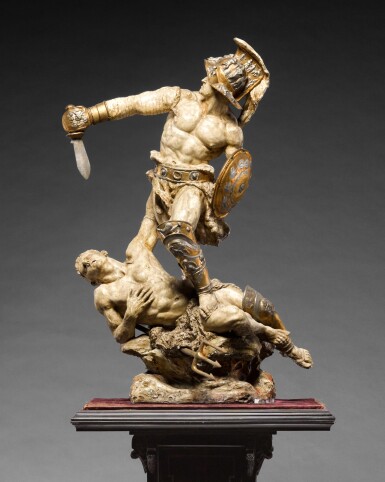
Viktor Tilgner
Gladiator and defeated Slave
Estimate
6,000 - 8,000 GBP
Lot Details
Description
Viktor Tilgner
Bratislava 1884 - 1896 Vienna
Gladiator and defeated Slave
signed and dated: Tilgner 1880 and numbered in ink: 1169
patinated and gilt plaster, on an ebonised wood plinth with gilt metal mounts, the top lined with purple velvet
group: 99cm., 39in.
plinth: 104.5cm., 41 1/8 in.
This extraordinary polychromed plaster group was modelled by the Viennese sculptor, Victor Tilgner. Born in Bratislava in 1859, Tilgner trained at the Akademie der bildenden Künste in Vienna until 1871. After initially mixed success, he was inspired to persevere as a sculptor after meeting Gustave Deloye (1838-99), who introduced him to the Baroque Revival style. Tilgner was an immensely successful portraitist, modelling busts of many members of Vienna’s social elite. He was, however, passionately interested in monumental sculpture, and was responsible for the designs for the sculptural programmes adorning many of the most important public buildings on Vienna’s Ringstrasse, including the Burgtheater and the Naturhistorisches Museum. Most famously, he created the monument to Wolfgang Amadeus Mozart in the Burggarten. Tilgner was a close friend of the fashionable painter Hans Makart (1840-1884), famed for his daring approach to colour and for his vast canvases based on mythological or historical subjects. The Gladiator and defeated Slave would undoubtedly have appealed to those with a taste for Makart’s paintings. It is clearly inspired by one of Jean-Léon Gérôme’s (1824-1904) greatest paintings, his Pollice Verso of 1872, in which a triumphant Gladiator treads his sandal into the neck of his defeated opponent, his sword held outstretched, whilst he turns towards the crowd for bloodthirsty instruction (Phoenix Art Museum, inv. no. 1968.52). The presence of original polychromy on the present group is typical of Tilgner’s approach to his plasters, and reflects the vogue for colour in sculpture at the end of the 19th century, a fashion, which had, in part, been borne out of the success of Gérôme’s own forays into the three dimensional at the end of his career.
RELATED LITERATURE
L. Hevesi, Victor Tilgners ausgewählte Werke, Vienna, 1897, p. 7; L. Medvecky (ed.), Tilgner, exh. cat. Bratislava City Museum, Bratislava, 1964
You May Also Like










